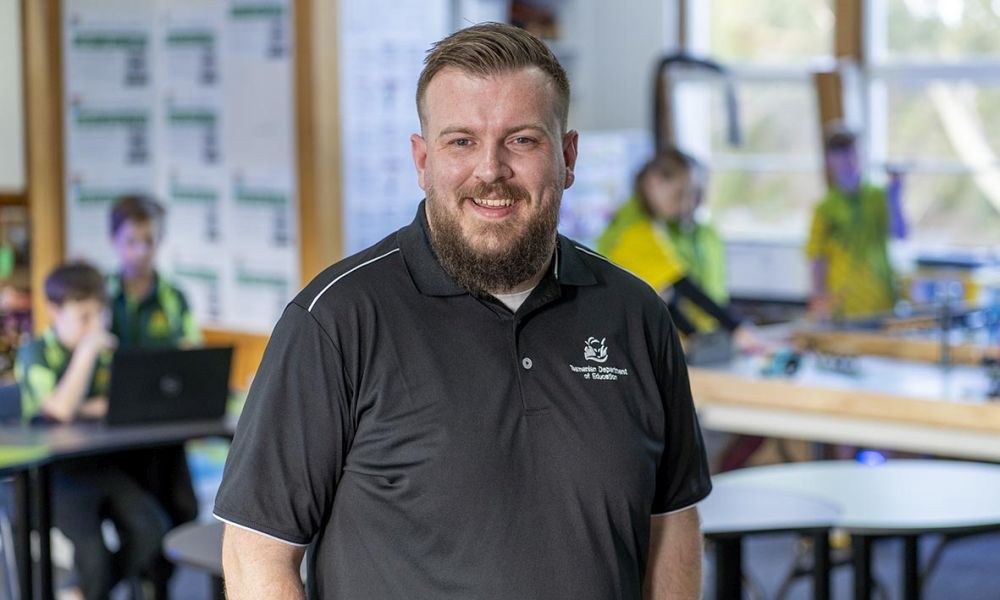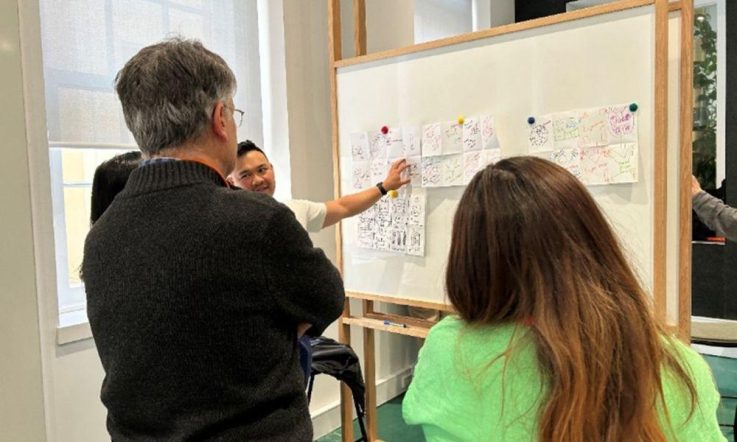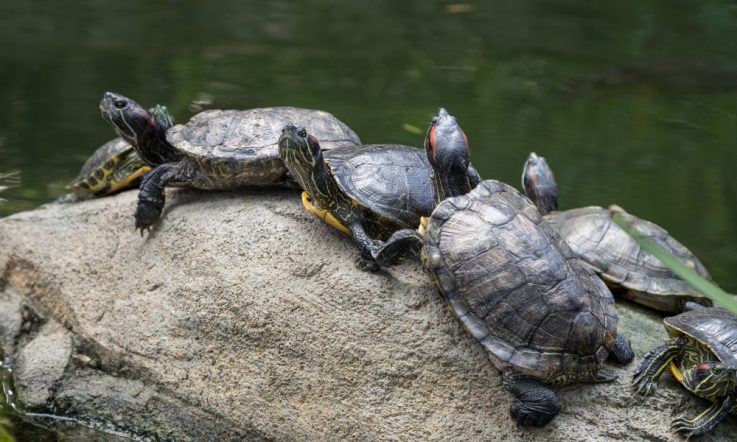It is estimated that 75% of jobs currently require STEM (Science, Technology, Engineering, and Mathematics) skills, with this figure rising to 90% in the future (CSIRO, 2023). To help build these crucial skills in its students, Montello Primary School in Burnie, Tasmania, has been teaching STEM as a subject since 2020 – largely through its Makerspace class. In these classes, students get to combine skills from all areas of STEM to undertake creative projects such as video game design, robotics, and much more.
In today's Q&A we speak to Daniel Edwards – STEM/Digital Technologies teacher at Montello Primary and Parklands High School, and the CEO and co-founder of STEM education charity GreenSTEM Education – about the value of STEM education, the amazing success his students have had, and what other schools can learn about teaching STEM.
Hi Daniel. When you first started at Montello Primary, prior to moving into your STEM teacher role, what was the STEM context there like?
Yeah, so [when I started as a teacher at Montello] STEM was a big part of my approach to teaching, having mostly taught high school maths and science prior to starting at Montello, that continued to grow and be more deeply integrated across teaching and learning in my class and across the school. [For example], I started an after-school Code Club as an extension of some of the units I was teaching in my classes and as a way for students from other classes to access valuable STEM and digital technologies learning opportunities.
From there, then Assistant Principal, Cam Hales, was a key part of how STEM continued to grow at Montello. We collaborated closely on a lot of projects to increase STEM and outcomes – the main one being our Makerspace, which is a dedicated learning space, equipped with resources, for teachers to bring their classes to and lead STEM lessons of their own.
How did Makerspace go from teachers leading STEM lessons, to actually you taking over that responsibility and shifting into the role of STEM teacher yourself?
During that first year [of Makerspace] there were very different levels of engagement and success across the school. Some classes were doing really well, and others weren’t so successful, and that was really dependant on teacher capacity and confidence. This led to a lot of teachers coming to me for support or to collaborate with them. While I fully embraced the enhanced learning outcomes and opportunities that the Makerspace and its resources provided, it was well out of the comfort zone of many teachers to plan, integrate and lead effective STEM learning.
Then, in late 2020, Cam submitted a successful grant application with Australia’s leading education charity, Australian Schools Plus, which included $30,000 in funding through a partnership with Google Australia to grow our Makerspace. Just as impactful as the funding was a year of strategic coaching from Dr Adrian Bertolini. This relationship led to me being involved with the organisation of Adrian’s It Takes a Spark STEM Education Conference in Tasmania – for the benefit of students and educators all over the state.
So, it [was decided] the program would benefit from having a dedicated specialist driving it and having a clear plan across all year levels. It would also benefit the teachers, as a part of my role (especially in the first year), was to support them to increase their capacity and their confidence in teaching STEM. During the first year, teachers accompanied their classes and learned alongside [their students].
What does a STEM class look like? What are your students going there to learn?
A big feature of my approach to STEM lessons is student-centred, project-based learning that really empowers students to become actively engaged, independent drivers of their own learning, with some agency over how they apply that learning. So not just copying a tutorial, and following steps, and everybody coming up with the same thing, but being able to apply their learning in all areas of STEM to research, develop and iterate innovative solutions to relevant, real-world problems. [Also] to be collaborating and working together – that’s always been a key approach from the beginning – all learning in the Makerspace is either in pairs or small groups.
My focus is on developing the 3 thinking frameworks that underpin STEM: computational thinking, systems thinking, and design thinking. That’s really at the core of all teaching and learning in my STEM classes.
What does that look like in terms of lesson activities?
Our students from grade 3 to 6 are currently designing and developing their own video games [for the ACER STEM Video Game Challenge]. So, students are working together in teams of up to 4 and applying their own strengths and interests across a range of learning areas – storytelling, art and visual design, audio design, and obviously programming as well. Multi-disciplinary projects such as these have been a key feature of my approach to teaching since well before I commenced my STEM specialist role.
Some of the projects [with younger students] are more guided, more of a gradual release of responsibility with a focus on developing strong foundational STEM skills and understanding. We’ve completed a unit using Lego Spike Essentials recently. The focus on that was developing an understanding of engineering design process and applying that to theme park rides – how engineering is used for fun but also for safety. Students applied their learning from these guided projects to work collaboratively with peers to design, build, program, test and improve a prototype of a new theme park ride.
A lot of what you do ends up getting entered into competitions, and with a lot of success too. Can you share some of those successes?
I’m so proud of the many outstanding achievements in STEM that so many of my students continue to make, with much of their success unprecedented for a Tasmanian school. Although it is always amazing to see students achieve such great success and recognition, we celebrate the learning that enables this first – instilling a belief that “what you learn is more important than what you win.”
Some notable achievements include Tasmanian winners in the grade 5/6 and grade 3/4 categories of the 2023 Young ICT Explorers Competition (also 2nd and 3rd place in the state for the 3/4 category), these groups then represented the school and state at the YICTE National Finals where the grade 3/4 team were awarded 3rd place nationally.
In 2022, we had [video games designed by] 2 teams selected among the Judges’ Favourites in the Raspberry Pi Foundation’s global Coolest Projects technology showcase. Out of only 4 games selected as favourites, 2 were from Montello – the first Australian teams ever recognised at this international showcase, and I think they had about 2,500 entries that year! They received medals from the UK and one of those teams has their game on display as part of a permanent exhibition at the Young V&A museum in London.
In 2021, we had a student win the Asia-Pacific region of the Microbit Do Your Bit competition. Also in 2021, a team of our students were awarded Tasmanian champions of the Tech Girls competition, with another group recognised with a national encouragement award. We’ve had awesome success in First Lego League over our 3 years participating, including our teams winning the Champion’s Award, Rising All-Stars Award and competing in National Championships. 4 of my students were selected amongst just 26 nationally for the inaugural CSIRO Stem Together Future Shapers program last year and another student was recognised as the 2023 BOP Industries Generation Alpha of the Year. We’ve had 3 First Nations students recognised as the Tasmanian winners of DeadlyScience’s Deadly Junior Scientist of the Year Awards over the last 2 years.
I am especially proud to see students of all abilities and diverse backgrounds achieve excellence in and develop a genuine passion for STEM.
Amazing! Aside from winning awards, what is the value of teaching STEM as a subject? What does it offer students that they can’t get from other subjects, or don’t get from taking maths and sciences individually?
One of the things with STEM that can be difficult to do in other learning areas is that it opens so many doors, opportunities and pathways, making visible and relevant connections to rapidly increasing career options.
Burnie is amongst the highest rates nationally for youth unemployment – it’s actually topped that list a number of times in recent years, so there are challenges for these students and the community. STEM can help make learning real, and it can highlight so many career opportunities that the students wouldn’t have been aware of – you can’t be what you can’t see.
Yeah, I know when I was at school, there were times where I would learn something and think ‘what’s the point of this?’ No one told me I could use calculus to make video games!
Exactly. So, it’s allowing them to make connections and see relevance. There’s an increasingly massive skill deficit [in STEM]. If we can support students to develop strong STEM skills it gives them a great head start and opens limitless opportunities for their futures.
I think the most significant and transformative impact, much greater than any awards or recognition, has been shifting the culture, the student’s belief and community perceptions. You might be in a small school in Burnie and think ‘there’s not much going on here’, but no matter the challenges and the barriers associated with this, STEM can empower you to achieve and be anything that you aspire to if you work hard towards that.
Before you go, a lot of schools are interested in STEM programs but maybe don’t know how to get it off the ground. There are teacher shortages, funding can be tight… What advice do you have to schools wanting to better implement STEM?
Reach out to another school or educator that has some experience with leading a successful STEM program and develop a coaching or mentoring relationship with them. Talk with them before throwing money at something. Have those conversations about what’s worked and what hasn’t.
Even then, it’s not about spending lots of money and buying a lot of resources. The thinking behind STEM remains the same no matter what you’re using, focus should be on developing student capacity in the core thinking frameworks that underpin STEM – it doesn’t really need to cost a lot of money.
One of the mistakes we maybe made at the beginning, and I believe many schools and educators launching a new STEM program similarly make, was being too resource-centric … ‘we’re going to use drones or do stuff with robots!’ But that shouldn’t be the focus. Think, ‘what are the learning outcomes?’, then ‘what resources are essential to achieve those?’
References
CSIRO. (2023, June 2) Why Choose STEM? With STEM You Can. https://research.csiro.au/WithSTEMYouCan/why-choose-stem/
Do students at your school undertake STEM projects? Is there the capacity to start integrating more STEM projects into your lessons?
Do your students understand the connection between what they learn, and how that knowledge can be relevant to their hobbies and interests, or be helpful to careers that interest them?
Daniel recommends speaking to other educators and schools with experience before ‘throwing money’ at a new project. Is this something you do before implementing new initiatives and programs at your school?



